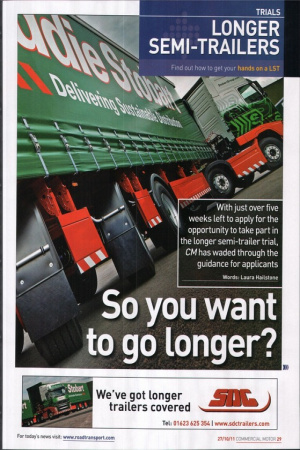Pulling out all
Page 27

Page 29

If you've noticed an error in this article please click here to report it so we can fix it.
the stops
Continued from front cover All in all, it’s a very British sort of pursuit. Having pulled in front of the two-axle Slovakian registered artic, the vehicle’s amber lights and rear display are switched on, giving clear instructions for the driver to follow us back to junction nine and VOSA’s sodden Leatherhead roadside check site.
HGV drivers are described as a compliant bunch, working hard in a heavily regulated business where checks are commonplace. In fact, according to our host, VOSA area manager Steve Hesmondhalgh, while there can be occasional language issues with foreign hauliers, it’s the occasional “highly non-compliant” Brits that VOSA inevitably comes into contact with who are the real light risks. Either way, frontand rear-facing cameras on each of VOSA’s vehicles, combined with its national network, makes avoidance ultimately futile.
However, despite operating at one of VOSA’s busiest sites in the country, occupying a plum position on the UK’s most infamous orbital road, with a high percentage of heavy hauliers from across Europe, trouble is rare. “Before we start a road check we let the police know as we need permission to use the hard shoulder, so they are aware and available if we need them,” says Hesmond halgh. “To be honest, the last potentially violent incident that I can remember taking place at the site was 12 years ago. While a vehicle was being examined we discovered it had a dodgy tax disc and, when confronted, the driver ate it. He was a big body-builder type so on that occasion we called for back-up.”
Key strategic site
In the case of the Slovakian-registered vehicle pulled today, Hesmondhalgh says the two-axle tractor is pretty typical of those favoured on the Continent as it provides more fuel tank space, but when pulled in they are often overweight on an axle because of this.
Leatherhead is a key strategic site for the agency given its location, but despite being manned throughout the week, typically with a total of eight staff over two shifts giving a VOSA presence at some point over each 24-hour period, this complement of stopping oficers (oficially known as enforcement support oficers), vehicle and trafic examiners, will on average inspect 20 vehicles a day. With an additional team, it rises to 30 and can go as high as 40 inspected vehicles, although this is rare.
Given the number of lorries using the X25, it means that for those breaking the law it is often worth trying to get away with it, because the odds of getting caught are the sort a Las Vegas high-roller would bite off your hand for. Hesmondhalgh’s team have even encountered foreign drivers armed with wads of UK notes that have been dolled out on departure from their depot, in case they’re pulled and hit with a ine. It gives a new meaning to “the cost of doing business”.
Outstanding prohibition
However, while the sheer volume of CVs using the X25 means only a small percentage can be pulled each day, a targeted approach means the respective success rate for VOSA in bringing in offenders is high. In the case of the stopped Slovakian vehicle, there was an outstanding delayed prohibition, issued to the vehicle and the same driver, that had not been cleared or rectiied. As a result, the VOSA examiner issued a further delayed prohibition notice for the defect, as well as a ixed penalty notice for knowingly driving under prohibition.
Technology makes all this possible. “There’s no value in pulling up the compliant,” says Hesmondhalgh. “We’ve had years of bad press, so these days it’s about leaving the good companies to get on with it.” One of the enablers for this is a series of copper bars known as WIXS (weigh in motion sensors) buried within the X25 on the approach to junction 9.
Every vehicle is weighed (on each axle) as it drives by and recorded by the automatic number plate recognition (ANPR) system, which is never switched off.
Cameras connected to the system take a snapshot of each vehicle’s number plate, with two side cameras providing a visual of the vehicle, whether it’s a car, van or lorry.
Information is fed to the local site and to VOSA headquarters in Bristol, where it is taken into the agency’s database, which also draws information from some other relevant government sources. This information is used to update each operator’s OCRS, helping to target those most likely to be non-compliant.
As one of VOSA’s key sites, Leatherhead has “all the














































